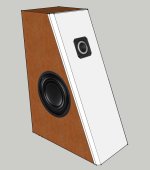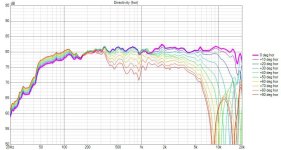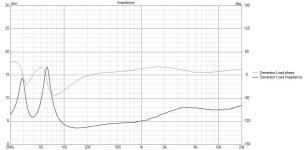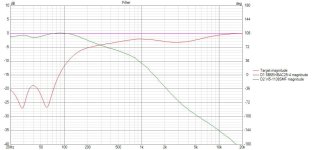Hey everyone,
While browsing through some old threads recently, I came across a neat little project from Paul Carmody dating back to 2013—the "Voxel" mini sub. For those unfamiliar, it’s a compact 7-liter subwoofer build using the Tang Band W5-1138SMF, capable of reaching down to about 35Hz (F3) in a surprisingly small footprint.
You can check it out here:
🔗 Voxel Mini Sub Thread


It sparked an idea:
What if we could adapt the Voxel design into a full-range "WAW" (Woofer-Assisted Widebander) system?
I’ve had a pair of SB Acoustics SB65WBAC25-4 full-range drivers collecting dust since they went on sale a few years ago. The thought was to let the Voxel handle the low end, while the SB65 tackles mids and highs on the front baffle.
Here's a link to the SB65's test data:
🔗 SB65 Driver Info

The drivers appear to have fairly compatible sensitivities. I’ve seen recommendations to cross the SB65 around 400Hz, and Tang Band’s spec sheet shows the W5 plays clean up to about 1kHz, so there seems to be a usable overlap.
I’m still fairly new to WAW-style designs and full-range applications, so I’d love to get some input before jumping in. Has anyone tried something similar? Any thoughts on enclosure tweaks, crossover approaches, or potential pitfalls?
Appreciate any insight—always grateful to learn from the experience of this community.
Cheers!
While browsing through some old threads recently, I came across a neat little project from Paul Carmody dating back to 2013—the "Voxel" mini sub. For those unfamiliar, it’s a compact 7-liter subwoofer build using the Tang Band W5-1138SMF, capable of reaching down to about 35Hz (F3) in a surprisingly small footprint.
You can check it out here:
🔗 Voxel Mini Sub Thread
It sparked an idea:
What if we could adapt the Voxel design into a full-range "WAW" (Woofer-Assisted Widebander) system?
I’ve had a pair of SB Acoustics SB65WBAC25-4 full-range drivers collecting dust since they went on sale a few years ago. The thought was to let the Voxel handle the low end, while the SB65 tackles mids and highs on the front baffle.
Here's a link to the SB65's test data:
🔗 SB65 Driver Info
The drivers appear to have fairly compatible sensitivities. I’ve seen recommendations to cross the SB65 around 400Hz, and Tang Band’s spec sheet shows the W5 plays clean up to about 1kHz, so there seems to be a usable overlap.
I’m still fairly new to WAW-style designs and full-range applications, so I’d love to get some input before jumping in. Has anyone tried something similar? Any thoughts on enclosure tweaks, crossover approaches, or potential pitfalls?
Appreciate any insight—always grateful to learn from the experience of this community.
Cheers!
I'm all for waw/fast designs, but in this case, don't expect meaningful bass down to 35Hz with that little enclosure and 5" sub.
The SB65 is absolutely wonderful, but it's not easy to cross. Certainly not as easy as slapping a capacitor and be done. It needs to be measured on baffle, with the woofer and tweaked so they match well. Even though I love the SB65, it's the one that always gets me to work the most trying to match it with other drivers. The reward is really nice when you get them right.
The SB65 is absolutely wonderful, but it's not easy to cross. Certainly not as easy as slapping a capacitor and be done. It needs to be measured on baffle, with the woofer and tweaked so they match well. Even though I love the SB65, it's the one that always gets me to work the most trying to match it with other drivers. The reward is really nice when you get them right.
Perceval, thank you for the response. Do you perhaps know of any DIY waw/fast designs that utilize the SB65 you could recommend? I was trying to scour the internet in hopes of finding such but haven't had much luck. 🤔
I've heard all these great things about these drivers, yet haven't found many builds utilizing them. (Outside of Line Arrays)
I've heard all these great things about these drivers, yet haven't found many builds utilizing them. (Outside of Line Arrays)

I actually have built the Voxel and it has great bass (even shaking some questionably built windows)
Clearly is SPL limited by design but it gives clean bass for its size and ease of build
Said that, I don't have idea if you could make it work with that full range
Clearly is SPL limited by design but it gives clean bass for its size and ease of build
Said that, I don't have idea if you could make it work with that full range
Attachments
-
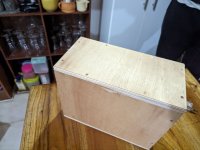 IMG_20250610_022648_623.jpg152.3 KB · Views: 64
IMG_20250610_022648_623.jpg152.3 KB · Views: 64 -
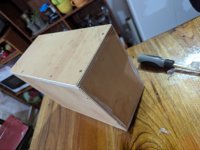 IMG_20250610_022648_979.jpg131.2 KB · Views: 60
IMG_20250610_022648_979.jpg131.2 KB · Views: 60 -
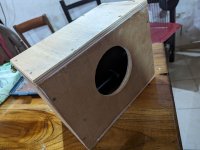 IMG_20250610_022648_827.jpg158.9 KB · Views: 62
IMG_20250610_022648_827.jpg158.9 KB · Views: 62 -
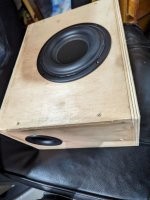 IMG_20250610_022654_568.jpg201.2 KB · Views: 60
IMG_20250610_022654_568.jpg201.2 KB · Views: 60 -
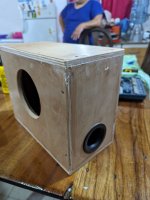 IMG_20250610_022648_911.jpg147.9 KB · Views: 65
IMG_20250610_022648_911.jpg147.9 KB · Views: 65 -
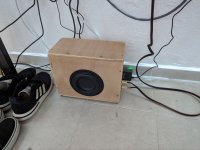 IMG_20250610_022700_812.jpg178.2 KB · Views: 65
IMG_20250610_022700_812.jpg178.2 KB · Views: 65 -
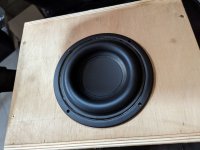 IMG_20250610_022654_206.jpg161.7 KB · Views: 63
IMG_20250610_022654_206.jpg161.7 KB · Views: 63
Sounds like a great idea zeltergiest.
Something I have been wanting to do for awhile.
What makes it incredible simple is a 90 degree woofer
Or side mounted woofer.
This also keeps the form factor skinny for the wideband.
Integration would be incredible easy.
Smooth and easy not much more than a cap and a coil for crossover.
The side mounted woofer makes the crossover easy.
Once the wideband is even on a simple highpass.
Distortion and clarity goes way up.
I was always looking at 6.5" woofers even 8"
But I think this woofer is interesting and workable.
Might have been the ticket all along.
The wideband seems to have a good SPL match at a quick glance.
Something I have been wanting to do for awhile.
What makes it incredible simple is a 90 degree woofer
Or side mounted woofer.
This also keeps the form factor skinny for the wideband.
Integration would be incredible easy.
Smooth and easy not much more than a cap and a coil for crossover.
The side mounted woofer makes the crossover easy.
Once the wideband is even on a simple highpass.
Distortion and clarity goes way up.
I was always looking at 6.5" woofers even 8"
But I think this woofer is interesting and workable.
Might have been the ticket all along.
The wideband seems to have a good SPL match at a quick glance.
Yes, Jim's CBT array comes right up when keying in the SB65, doesn't it? 🙂 It is a great design.
Having built OB, woofer TL and the SB65 as wide range, and a little sealed project, I can say that the SB65 is not as easy as slapping a cap on it, and an inductor on the woofer.
I wouldn't go much lower than 400Hz with the SB65. Its strengths are high extension close to tweeter territory, and its ability to reproduce fast transients like plucked guitars, percussion, anything that has a quick attack. It even sounds amazing on woodwinds. But it needs help below 400Hz to make it shine.
I don't know of any made and available designs for the SB65 besides Jim's CBT. It's a shame because it is a great driver.
So, you'll have to do the work. But it will be rewarding.
Having built OB, woofer TL and the SB65 as wide range, and a little sealed project, I can say that the SB65 is not as easy as slapping a cap on it, and an inductor on the woofer.
I wouldn't go much lower than 400Hz with the SB65. Its strengths are high extension close to tweeter territory, and its ability to reproduce fast transients like plucked guitars, percussion, anything that has a quick attack. It even sounds amazing on woodwinds. But it needs help below 400Hz to make it shine.
I don't know of any made and available designs for the SB65 besides Jim's CBT. It's a shame because it is a great driver.
So, you'll have to do the work. But it will be rewarding.
like I said, I have simulated, and built a few designs already with the SB65.Not that hard with side mounted woofer.
Can easily sim for you.
Real world data taken from the the SB65 on a baffle, and combined with the woofer(s). REW, HornResp, XSim... the works.
Most of the time, it is not so hard, but the SB65 was a little different. It needed work.
Side-firing midwoofer ought to begin off-axis fall-off above 1.5khz (unless wall-bounced) so HF resonances are naturally attenuated. I used my SB65 over up-firing widerange, XO-less XL-cardioid (reduced rear output due to nude fullrange backwave cancelling widerange back-half), acoustic centers time-aligned (holographic depth). The Voxel wouldn't allow that offset alignment (unless toed-in exactly right, perhaps in a Spica-like side-sloped baffle?) so LP filter ideally ought to be designed/tweaked to take into account final toe-in (drivers non-equidistant from ear depending on toe-in) and also probable side-wall reflections.
(Didn't take a picture of the wall-mounted TL; only this.)
I did a minimalist LX SB65 over IREL vintage alnico 2.5x10in very short TL on-wall (with 4cm sound-absorber board).
(Didn't take a picture of the wall-mounted TL; only this.)
Hi, could you share the correction you used, thanks.I have built some speakers with the SB65, which is a metal (alum) cone. Again, it needs a little correction, but once added, wow... never had a single driver that had so much attack and detail in stringed instruments. It's mesmerizing.
I did a minimalist LX SB65 over IREL vintage alnico 2.5x10in very short TL on-wall (with 4cm sound-absorber board).
I suspect that might be indeed the best possible nearfield setup. But my...
Starting with a very specific baffle size/ratio
I can get the SB65 relatively flat using simple methods.
Noted, it is nice they didnt hide the top end peaking in the datasheet.
This top end peaking is easily fixed with a tilted baffle.
This case 22 degree slant
Graph shows response on baffle, orange trace = 0 degree on Axis
Blue Trace = 22 degree Baffle
Response is flat enough for crossover area, small peak around 2 kHz about 3.5 dB over the average
can be solved with a plain simple notch. Outcome be a nice 81/82 dB average

I can get the SB65 relatively flat using simple methods.
Noted, it is nice they didnt hide the top end peaking in the datasheet.
This top end peaking is easily fixed with a tilted baffle.
This case 22 degree slant
Graph shows response on baffle, orange trace = 0 degree on Axis
Blue Trace = 22 degree Baffle
Response is flat enough for crossover area, small peak around 2 kHz about 3.5 dB over the average
can be solved with a plain simple notch. Outcome be a nice 81/82 dB average
Last edited:
This is sealed wideband on high pass.
Non of the distortion you imagine exist in proper enclosure.
This driver has resonance of 115 Hz and has overhung coil.
Its compliance and suspension are specifically for enclosure.
Using in vented or open baffle is were your distortion comes from.
Not mine. = no cone control = distortion.
Not in sealed and not with high pass.
a higher crossover will actually create a very poor impedance dip around 2.8 ohms.
So far your " not so simple" theory has been disproved.
My impedance is smooth 4 to 8 ohms.
It is very good match even for transformer coupled amplifiers.
Everything is done for specific reason, not "Wild guessing"
Or I like to argue
Non of the distortion you imagine exist in proper enclosure.
This driver has resonance of 115 Hz and has overhung coil.
Its compliance and suspension are specifically for enclosure.
Using in vented or open baffle is were your distortion comes from.
Not mine. = no cone control = distortion.
Not in sealed and not with high pass.
a higher crossover will actually create a very poor impedance dip around 2.8 ohms.
So far your " not so simple" theory has been disproved.
My impedance is smooth 4 to 8 ohms.
It is very good match even for transformer coupled amplifiers.
Everything is done for specific reason, not "Wild guessing"
Or I like to argue
No worries.
I don't mind being proven wrong.
You've used online graphs to come up with the XO, I used actual impedance and FR data taken from the drivers on their physical baffle.
I don't mind being proven wrong.
You've used online graphs to come up with the XO, I used actual impedance and FR data taken from the drivers on their physical baffle.
The sim includes baffle diffraction
And modeled to extensive accuracy, which is why CAD drawings are created
to sim to 1mm accuracy. For actual distances and correct phase
Often home measurements are filled with inaccuracy.
And improved and sorted by resorting to factory data.
SB acoustics was nice enough to not hide the top end phase wobble response expected
from wide bands.
Hence, the baffle size and 22 degree baffle angle can be very accurately designed to help remove it.
It was a massive export of 1 degree increments. Highly unlikely to measure at home to 1 degree
To 180 degrees, without going bonkers.
My last sim to build was a dead match for response and impedance.
What did not match was manufacture hiding top end wobble.
Nice it was included. off course with generous smoothing and cutoff at 20k...but there regardless.
And modeled to extensive accuracy, which is why CAD drawings are created
to sim to 1mm accuracy. For actual distances and correct phase
Often home measurements are filled with inaccuracy.
And improved and sorted by resorting to factory data.
SB acoustics was nice enough to not hide the top end phase wobble response expected
from wide bands.
Hence, the baffle size and 22 degree baffle angle can be very accurately designed to help remove it.
It was a massive export of 1 degree increments. Highly unlikely to measure at home to 1 degree
To 180 degrees, without going bonkers.
My last sim to build was a dead match for response and impedance.
What did not match was manufacture hiding top end wobble.
Nice it was included. off course with generous smoothing and cutoff at 20k...but there regardless.
Last edited:
Wow, thank you so much for taking the time to do this! I really like your design and solutions here. It will be fun to bring this to fruition and play around with. Do you care if I use this for a future write up once completed? Thanks.There you go it is that easy.....
300 Hz crossover
I do not " make up" alignments
I use absolutely standard alignments
4th order vented C4
10.4 liters 38 Hz Fb
Whatever port you want on the back or front.
View attachment 1471418
View attachment 1471419
View attachment 1471420
View attachment 1471421
View attachment 1471431
View attachment 1471429
View attachment 1471430
I like it, good job!There you go it is that easy.....
300 Hz crossover
I do not " make up" alignments
I use absolutely standard alignments
4th order vented C4
10.4 liters 38 Hz Fb
Whatever port you want on the back or front.
View attachment 1471418
View attachment 1471419
View attachment 1471420
View attachment 1471421
View attachment 1471431
View attachment 1471429
View attachment 1471430
Called out sick, so actually had a day to work on it.Wow, thank you so much for taking the time to do this!
Go for it. The crossover is specific to the side mounted woofer and baffle size.
I just didnt calculate the port. 2 to 2.5" should work whatever length to get 38 to 40 Hz
- Home
- Loudspeakers
- Full Range
- Exploring a "Voxel WAW" Hybrid – Thoughts?
